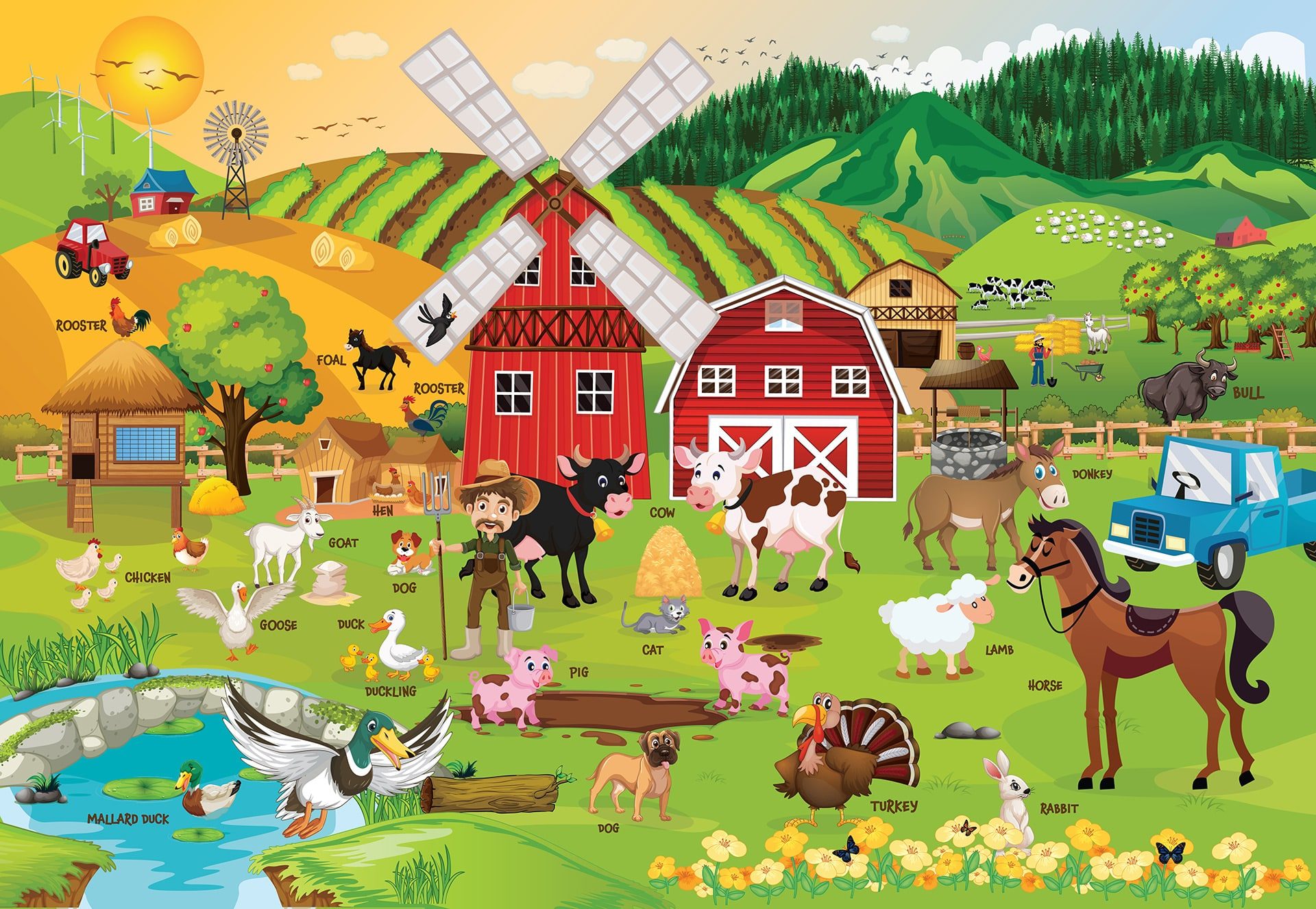Educational jigsaw puzzle with Farm animals.
Hey, there! Ready for a farm animal jigsaw puzzle adventure? Are you eager to experience the beauty of living in the countryside?
Once this animals jigsaw puzzle with 240 pieces for 7 year olds is ready, your farm adventure among domestic animals moves online. Click below and discover useful, interesting, and funny information about all the countryside animals you’ve found in your favorite farm animal puzzle.

<<< SWIPE TO EXPLORE >>>

Bull
Scientific name: Bos taurus
It is an uncastrated male belonging to the large horned cattle group.
Although it has a natural instinct to attack when it feels threatened, the bull can be trained to be calm and docile.
It has a good memory and can remember things for several years.
Has a strong sense of smell and can detect scents up to five miles away.
In some cultures, bull testicles are eaten as a specialty and it is believed that they give strength and virility.

Cat
Scientific name: Felis catus
Can jump up to six times its own body length.
A cat’s nose print is unique, just like a human’s fingerprint.
Cats can’t taste sweet things because they lack the necessary taste buds.
Most cats are lactose intolerant and should not be fed with milk.
Whiskers help cats in orientation, sniffing, maintaining balance and even measuring distances.

Chicken
Scientific name: Gallus gallus domesticus
These delicate birds reach maturity in 5 to 9 months, depending on the breed.
The hens empathize with the chicks and communicate with them before they hatch.
Chicken use over 20 different vocalizations to communicate.
The chicken’s retina can detect ultraviolet waves, which are invisible to the human eye.
Chicken can dream in their sleep just like humans.

Cow
Scientific name: Bos taurus
The cow’s stomach has 4 compartments, each of which plays an important role in the digestion process.
Cows can recognize up to 50 different members of their herd.
They can also detect the smell of stress hormones in other cows’ urine.
It takes about 100 hand movements to extract a litre of milk from the cow’s udder.
In Hinduism, the cow symbolises the laws of the universe and is considered a holy animal.

Dog
Scientific name: Canis lupus familiaris
It was the first animal domesticated by man, about 12,000 years ago.
It can smell a thousand times better than humans.
The wetness of a dog’s nose helps them pick up scents better.
The poodle is one of the most intelligent dog breeds.
Dogs can learn over 150 words and can even understand basic arithmetic.

Donkey
Scientific name: Equus asinus
This smaller relative of the horse can live up to 50 years.
Can make a wide range of sounds, including grunts, brays, and snorts.
It has a keen sense of hearing and can detect sounds up to two miles away.
Despite popular belief, the donkey is not at all stubborn.
It has an incredible memory, being able to recognize areas or animals it encountered decades ago.

Duck
Scientific name: Anas Platyrhynchos
These birds are found everywhere in the world except Antarctica.
Ducks began to be raised as domestic poultry more than 500 years ago.
They have waterproof feathers that keep them dry even when swimming.
The duck traces its nest with feathers that it plucks from its breast.
They have a wide range of vocalizations, including quacks, honks, and whistles.

Duckling
The ducklings hatch after the mother duck has laid her eggs for 21-28 days.
Baby ducks are able to walk shortly after hatching.
Ducklings can also swim as soon as their fluff dries after hatching.
A duckling will immediately attach itself to the first living thing it sees when it hatches.
Mallards will drive their newly hatched babies even 1 km away to find a suitable water source.

Foal
Can stand and walk just a few hours after being born.
The foal can sleep both standing and lying down.
It starts eating grass a week after birth.
It recognizes its mother’s smell and voice within a few days of birth.
Communication between a horse and its foal is almost imperceptible to the human eye.

Goat
Scientific name: Capra aegagrus hircus
Domestic goat is descended from wild goat originating in Turkey.
It is a great climber: can climb trees and mountains with ease.
Goats have rectangular pupils that allow them to see 320 degrees around them without having to move their heads.
Goats have a natural fear of water and don’t like to get wet.
Goats have been known to “faint” when they’re scared or excited.

Goose
Scientific name: Anser anser
It was domesticated in Egypt about 3000 years ago.
It is the most intelligent domesticated bird and has a very good memory.
Geese can live up to 25 years in the wild.
They are very loyal and mate for life.
The male goose is fiercely protective of his mate when she is hatching.
Some geese are used as “guard geese” to protect farms and gardens from intruders.

Hen
Scientific name: Gallus gallus domesticus
The best-known domestic bird can run up to 10 km per hour.
A hen can lay over 300 eggs per year!
A hen has a good memory being able to distinguish more than 100 faces of its own species.
The color of an egg depends on the color of the hen’s earlobes.
Worldwide, 97 hens are killed every 0.05 seconds.

Horse
Scientific name: Equus caballus
The world’s longest living horse, Old Billy, was from the USA and lived for 62 years.
Horses’ hooves contain the same protein found in human hair and nails.
The horse cannot vomit or burp.
It only breathes through his nose, it can’t breathe through his mouth.
It never drinks water after other animals or from dirty containers.

Lamb
Scientific name: Ovis aries
The domestic sheep probably originates from the wild Asian mouflon species.
Can recognize and remember up to 50 different faces, including other sheep and humans.
Lamb has a natural fear of loud noises and sudden movements.
Can be trained to run obstacle courses, just like dogs.
In Europe, the largest sheep breeding country is the UK.

Mallard Duck
Scientific name: Anas platyrhynchos
It is an omnivorous bird with a varied diet that includes insects, various plant species and fish.
Some species can reach speeds of up to 100 miles per hour in flight.
Most of the time, they fly in a V-shape to save energy.
Mallards often mate with males of domestic species.
The flight orientation of mallards is a mystery. It is believed that they orientate themselves by the sun.

Pig
Scientific name: Sus scrofa domesticus
This animal is believed to have been domesticated 9000 years ago.
Pigs love to play with a ball, sit in the sun or explore their environment.
The squeal of a pig beats the decibel level of a chainsaw.
They have a complex psychology and are considered intelligent and emotional creatures.
În China, oamenii obișnuiesc să țină în dormitor statuete cu porci, aceștia simbolizând fertilitatea.

Rabbit
Scientific name: Oryctolagus cuniculus
A rabbit’s teeth are constantly growing, so they feel the need to nibble all the time.
A female can give birth to up to 7 baby rabbits at a time.
The rabbit sleeps with its eyes open.
Rabbit ears can reach up to 6 m in length.
It runs in a zigzag when it feels in danger, to confuse its predator.

Rooster
Scientific name: Gallus gallus domesticus
Can crow up to 20 times per day.
It has a sharp spur on the back of the legs that it can use for self-defense.
Is known to exhibit altruistic behavior, like protecting the hens from predators or sharing food.
The fertility of roosters is higher in sunny seasons.
A symbol of courage and power, the rooster is the only bird in the Chinese zodiac.

Turkey
Scientific name: Meleagris gallopavo f. Domestica
It is one of the most impressive domestic birds said to have the healthiest meat.
Due to the high demand for its meat, turkey eggs are not commonly sold in supermarkets.
Turkey’s dung is used as a fuel source in power plants.
Wild turkeys can fly short distances of up to 90 km per hour.
Depending on their mood, turkeys can change the color of their head and neck skin.




